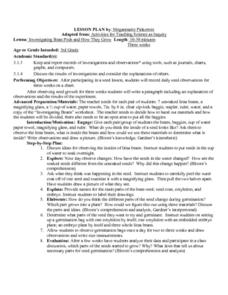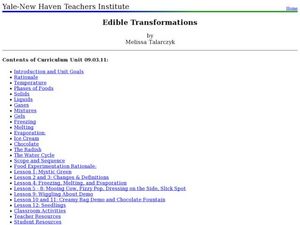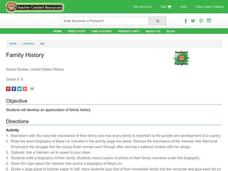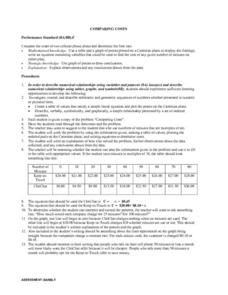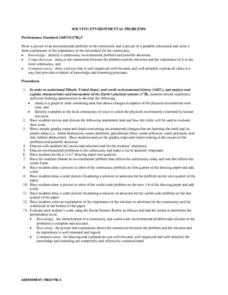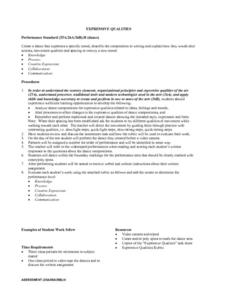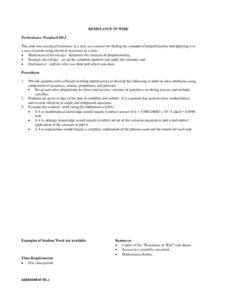Curated OER
Cultural Creation Myths
Students write original plays based on supernatural explanations of existence. In this cultural creation myths lesson, students listen to five different stories about supernatural creation. Students record similarities and differences in...
Curated OER
The Coffee House
Students study and write poetry. In this poetry project, students read, analyze, and produce poetry. Students examine and analyze fifteen poems and at the culmination of the unit, perform one of their poems for an audience.
Curated OER
Investigating Bean Pods and How They Grow
Third graders observe and create a record of seed growth over time. After planting a seed, 3rd graders record their observations of the seed's growth over a three week period. Upon conclusion of the experiment, they write a paragraph...
Curated OER
CREATE A NEW RHYME
Third graders develop basic narratives. They retell a focused story and create a basic publication using available resources (e.g., pictures, colors, computer, copier). They experiment with different forms of creative writing (e.g.,...
Curated OER
Edible Transformations
Learners differentiate the different phases of matter. In this chemistry lesson, students conduct several hands-on exercises to discover how matter transforms when mixed together. They identify the different stages in the water cycle.
Curated OER
Family History
Students appreciate how families are important to the expansion and progress of a country. In this biographies lesson, students read a biography and write their biographies including photos. Students create family trees.
Curated OER
Comparing Costs
Learners compare the costs of two cellular phone plans and determine the best rate. They use a table and a graph of points plotted on a Cartesian plane to display their findings. Students write an equation containing variables that could...
Curated OER
Family Names
Young scholars draw a family tree. They label familiar items (e.g., family members, classroom objects, and pets). Pupils are given a copy of the worksheet "Family Name," they draw a family tree, label themselves and at least 10...
Curated OER
Lighting Instruments from the Inside Out
Students examine theatrical lighting instruments to see how light is controlled, and write a paragraph telling of their discoveries.
Curated OER
Using Adjectives
In this language arts lesson, students listen to the book "Many Luscious Lollipops," in order to become familiar with adjectives. Students create four comic strip squares, using five adjectives in each square, after
hearing the book....
Curated OER
Echinoderms
In this echinoderm worksheet, students will explore the characteristics of echinoderms including their body structures and larval stages. Then students will match the five classes of echinoderms to their descriptions. This worksheet has...
Curated OER
Shapely Figures
Students are given magazines, scissors, glue, and one sheet of construction paper. They look for pictures showing real life representations of rectangular prisms, spheres, cones, and pyramids. Pupils cut out pictures showing each of...
Curated OER
Solving Environmental Problems
Students identify a community environmental problem and possible solutions. They analyze the connection between the problem and the solutions and the importance of it to the local community. Students then draw a picture of an...
Curated OER
GANDHI'S INDIA
Students describe key events in the life of Gandhi. They determine why knowledge of geography is necessary to understand the history of the people in a place or region. They write a summary of how the events in Gandhi's life,...
Curated OER
Tectonic Plates, Earthquakes, and Volcanoes
Challenge geography classes to locate the major volcanoes and earthquake faults on a world map. In groups, they identify the pattern made and examine the relationship between the locations of the faults and volcanoes and tectonic...
Curated OER
EXPRESSIVE QUALITIES
Students create a dance that expresses a specific mood. They describe the composition in writing and explain how they would alter actions, movement qualities and spacing to convey a new mood. They perform the dance they created...
Curated OER
SENSORY ELEMENTS
Students describe the sensory elements of musical selections (i.e., tempos, dynamics, and articulations). They write an essay evaluating Saint-Saens' effectiveness in using sensory elements in both selections. They describe the...
Curated OER
NUMBER MATCH
Students relate the written form to the spoken form of familiar language (e.g., simple greeting, basic vocabulary, numbers, dates, time). They practice counting objects, identifying numbers when presented on flash cards in random order...
Curated OER
Greetings and Introductions
Students recite common forms of courtesy, greetings and leave takings appropriate to the time of day. They practice identiying the differences in forms of address for age and rank. Pupils are each given a copy of the "Greetings and...
Curated OER
Specialty Crop Production/Orchids
Twelfth graders explore the fascinating world of orchid production including propagation, care, culture, and finishing. They complete market research and design a production schedule for an orchid crop of their choice. They write a short...
Curated OER
Arkansas History Lesson: Arkansans
Third graders investigate famous Arkansans and their contributions. In this Arkansas history instructional activity, 3rd graders are divided into small groups and use a variety of resources to research one important Arkansan. Students...
Curated OER
Pumpkins!
Students discuss emotion, draw pumpkin faces and write about the way their pumpkin is feeling. In this emotions lesson, students make pumpkin faces and match pumpkin seeds to a card with seeds.
Learning to Give
Closing Ceremonies
Promote volunteerism in your art or writing classes. In this service learning lesson plan, middle schoolers create promotional materials that include photographs and newspaper articles based on their personal service experiences in local...
Curated OER
Resistance in a Wire
Students find the constant of proportionality and apply it to a situation. They use the electrical resistance in a wire as a context for finding the constant of proportionality. In addition, they write an explanation and justification of...


